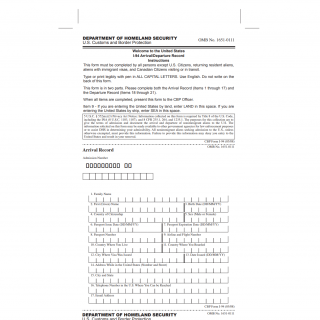CBP Form I-94. Arrival/Departure Record, for documenting foreign visitors' arrivals and departures from the United States
If you are traveling to the United States as a non-immigrant, you will be required to fill out the CBP Form I-94, also known as the Arrival/Departure Record. This form is used by the U.S. Customs and Border Protection (CBP) to document your arrival and departure from the U.S. and to track your authorized stay in the country. In this article, we will provide a detailed description of the CBP Form I-94, including its purpose, parts, important fields, parties involved, cases when the form is compiled, features to consider when compiling, advantages of the form, problems that can arise when filling it out, related forms, differences from analogues, and where and how the form is submitted and stored.
The CBP Form I-94 serves as a record of arrival and departure for non-immigrant travelers to the United States. The form is used to document the length of your authorized stay in the country and to keep track of your movements within the U.S.
The CBP Form I-94 consists of several parts, including the first section, which requires personal information such as your name, date of birth, country of citizenship, and passport number. The second section requires you to provide information about your travel, including your flight number, airline, and the city where you boarded the plane. The third section is where the CBP officer will stamp your form with the date and location of your entry into the U.S. The fourth section is for your departure information, including your flight number, airline, and the city where you will depart from the U.S.
The most important fields on the CBP Form I-94 are those that pertain to your personal information, travel information, and the CBP officer's stamp. It is important to ensure that all of the information you provide on the form is accurate and up-to-date.
The parties involved in the CBP Form I-94 are the traveler and the CBP officer who processes the form upon your arrival in the U.S.
The CBP Form I-94 is compiled by non-immigrant travelers to the U.S. when they arrive in the country.
When compiling the CBP Form I-94, it is important to ensure that you provide accurate and up-to-date information. You should also make sure that you have all of the necessary documentation, including your passport and visa.
The CBP Form I-94 provides a record of your authorized stay in the U.S. and can be used to prove your legal status in the country. It is also used by the U.S. government to track the movements of non-immigrant travelers.
One of the most common problems that can arise when filling out the CBP Form I-94 is providing inaccurate or incomplete information. This can result in delays or even denial of entry into the U.S. It is important to ensure that all of the information you provide on the form is accurate and up-to-date.
Related forms include the CBP Form I-102, Application for Replacement/Initial Nonimmigrant Arrival-Departure Document, which is used to replace a lost or stolen CBP Form I-94. Alternative forms include the CBP Form I-94W, Nonimmigrant Visa Waiver Arrival/Departure Record, which is used by travelers from certain countries who are visiting the U.S. for business or pleasure for a short period of time.
The CBP Form I-94 differs from analogues in that it is used specifically for non-immigrant travelers to the U.S. and is used to document their authorized stay in the country. Other forms, such as the CBP Form I-102 and the CBP Form I-94W, serve different purposes.
The CBP Form I-94 is submitted to the CBP officer upon your arrival in the U.S. and is stored electronically in the CBP's database. You can access your electronic record of your CBP Form I-94 online by visiting the CBP website.
In conclusion, the CBP Form I-94 is an important document for non-immigrant travelers to the U.S. It serves as a record of their authorized stay in the country and can be used to prove their legal status. It is important to ensure that all of the information you provide on the form is accurate and up-to-date to avoid any problems when entering or leaving the U.S.

